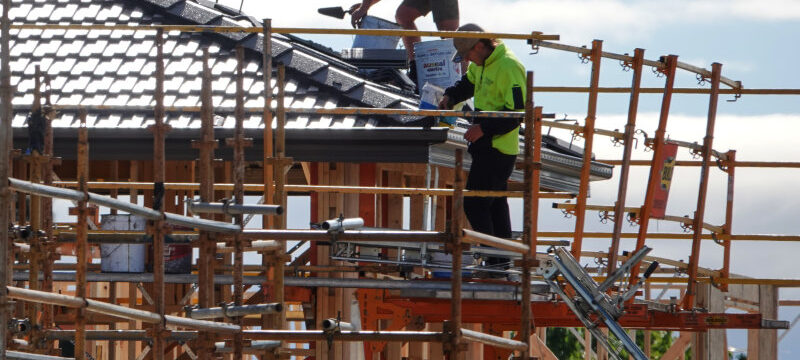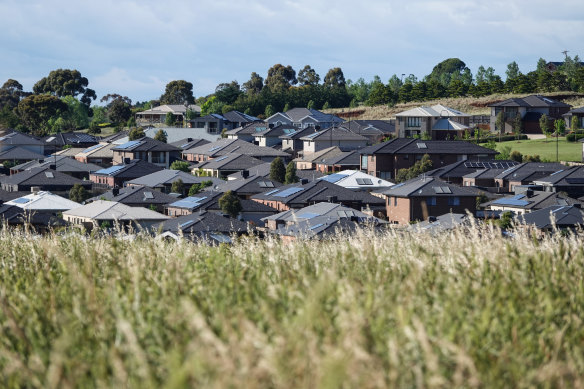Save articles for later
Add articles to your saved list and come back to them any time.
Victoria’s developer levy designed to pay for roads, schools and hospitals on Melbourne’s fringes should be dumped and replaced with a new charge because it fails to raise enough revenue, the state government’s key infrastructure adviser has warned.
Infrastructure Victoria has urged the Andrews government to scrap the much-maligned Growth Areas Infrastructure Contribution (GAIC) – a charge that only targets developments on Melbourne’s fringe.
The government is adamant that Melbourne must stop expanding on its fringes and accept high density in existing boundaries.Credit: Paul Rovere
With Melbourne set to overtake Sydney as Australia’s largest city in about a decade, supplying infrastructure and services for fringe development is set to involve a far bigger cost to taxpayers.
Analysis by development experts SGS Economics and Planning commissioned by Infrastructure Victoria shows the state is required to spend $50,000 on local infrastructure for every new growth area home.
But the GAIC – a charge introduced by the former Labor state government in 2010 – claws back just $6100 per new dwelling, leaving taxpayers to foot the remaining 88 per cent of the bill, the research says.
Infrastructure Victoria chief executive Jonathan Spear called for a new infrastructure collection system that would apply more broadly across Melbourne, rather than only on the fringes.
Infrastructure Victoria chief executive Jonathan Spear is calling for a new infrastructure collection system that would apply more broadly across Melbourne.
“The reality is we need funding to support development in established areas as well,” Dr Spear told The Age. “We should apply infrastructure contribution charges to all areas where there is development. It should be simple and predictable in each development setting.”
He said such a system might mean that apparently cheap blocks of land on the fringes “shouldn’t be so cheap”.
“Our research shows that the cost of infrastructure in growth areas can be up to four times higher than in established suburbs. The current charge doesn’t reflect the true cost of infrastructure needed to service greenfield communities. That means it is sending the wrong price signal.”
The government’s housing statement this week aims to free up government land for higher density housing and provide developers with faster approvals.
Premier Daniel Andrews remains adamant that Melbourne cannot afford to keep expanding at its fringes at the current rate, with the state government aiming to add an extra 1 million homes to existing suburbs by 2050.
Marcus Spiller, a planning expert from SGS, said Victoria was one of first states to introduce a so-called “betterment tax”, in the form of the GAIC. But he said the idea should now be applied universally across Melbourne as a development licence fee linked to the approval of developments.
He said this would also mitigate corruption risks if the lure of large profits from rezoning was reduced.
“If we had a system that garnered a reasonable proportion for infrastructure we would have a lot more funding for infrastructure and the planning system would work better, with less rent-seeking by developers,” Spiller said.
It also follows a March 2020 report by the Victorian Auditor-General warning that the current system of charging developers is “not delivering the infrastructure needed by growing communities to support their quality of life”.
Asked if the government was considering replacing the GAIC, a spokesperson for the state government said the government was constantly reviewing the revenue system to make sure it was appropriate to fund services and infrastructure.
“Every dollar of the (GAIC) is spent on providing infrastructure for growing communities, like schools and ambulance facilities,” the spokesperson said.
The government says it has spent more than $635 million collected from the GAIC on almost 120 infrastructure projects.
As revealed by The Age this week, the Andrews government dumped an ambitious cabinet-approved plan to lift the proportion of social housing in Victoria by almost two-thirds to 4.5 per cent of the total housing stock, opting instead to respond to the housing crisis with a voluntary, developer-led delivery of so-called affordable housing.
It comes amid criticism that it has capitulated to the property lobby, announcing a suite of measures this week expected to generate billions of dollars of extra profits through streamlined approvals, with very little downside in return.
But the government is also working on further planning reforms likely to be unveiled later this year, including a new system of charging developers for infrastructure.
The Morning Edition newsletter is our guide to the day’s most important and interesting stories, analysis and insights. Sign up here.
Most Viewed in Politics
From our partners
Source: Read Full Article


